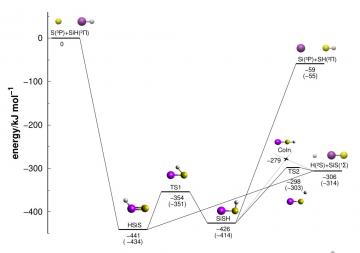RESEARCH ARTICLE: SiS formation in the interstellar medium via SiH + S collisions

Abstract: One of the most important Si-bearing species in the intersellar medium is the SiS molecule. Thermal rate coefficients and other collisional properties are calculated for its formation via the title reaction using the quasi-classical trajectory method. An accurate representation of the HSiS potential energy surface is employed, which has been modelled from high-level ab initio calculations and a reliable description of long-range interactions as implied by the underlying double many-body expansion method. The calculated rate coefficients for the reaction can be modelled with k(T) = α(T/300)βe−γ/T where , β = -0.11, and . This result is only slightly lower than that for SiS formation via Si + SH collisions. The contribution of each reaction mechanism and the rovibrational energy distributions of the nascent SiS molecule are also calculated. The title collision can also yield SH (), but the corresponding rate coefficient is 20 to 27 times smaller than for SiS formation (, β =-0.13, and ). The role of intersections between excited electronic states is also discussed, based on novel calculations including eight electronic states.
Full paper here.
